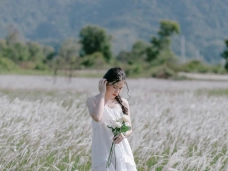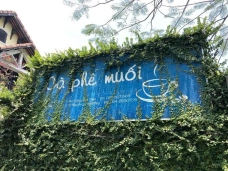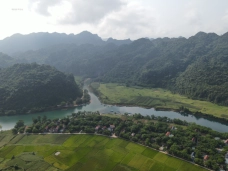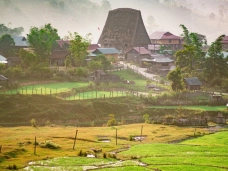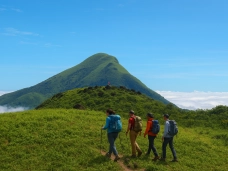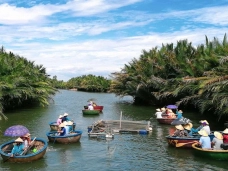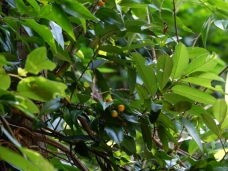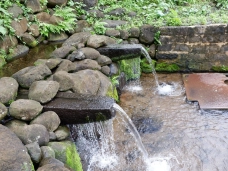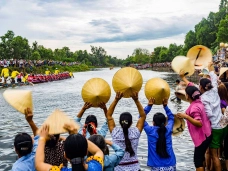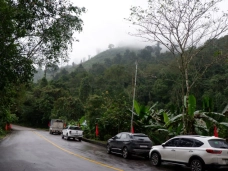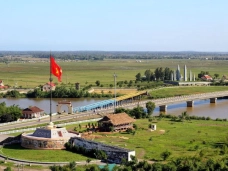The Story of the Ma-Coong Drum-Beating Festival
08-02-2025 11:13
I have had many opportunities to visit the Phong Nha – Kẻ Bàng mountainous region, a place rich in fascinating geological, geomorphological, and biodiversity features of the natural world. This area has been extensively explored and globally recognized for its significance. Beyond its natural values, the region also holds many cultural mysteries. The people here exhibit unique characteristics due to the geographical isolation of the terrain. Despite covering a relatively small area, it is home to nine ethnic groups. The Bru-Vân Kiều ethnic group consists of the Vân Kiều, Ma-Coong, Trì, and Khùa subgroups, while the Chứt ethnic group includes the Arem, Rục, Mày, Mã Liềng, and Sách subgroups.

One of my destinations on this journey was the settlement of the Ma-Coong people. This ethnic group lives in relative isolation in the Trường Sơn mountains, along the Vietnam-Laos border, about 60 km from Phong Nha Town, Bố Trạch District, Quảng Bình Province. Traveling by car along Highway 20, the journey takes about three hours. Today, the Ma-Coong people reside in 18 villages in Thượng Trạch Commune, Bố Trạch District, Quảng Bình Province.
According to the elders, in ancient times, deep in the vast Trường Sơn mountains, a peaceful group of people lived in Thượng Trạch. They were the ancestors of today’s Ma-Coong people. Over generations, they became deeply connected to the forests, living through farming, hunting, and gathering. As a result, their spiritual life is closely tied to the sky, earth, rivers, and mountains. Their belief system is rooted in polytheism, which forms the foundation of their spiritual culture. The Drum-Beating Festival is a cultural tradition that embodies the Ma-Coong people's philosophy of life.
The Legend of the Drum-Beating Festival
According to legend, long ago, the Ma-Coong villages enjoyed peace, lush greenery, abundant crops, and harmonious wildlife. However, one year, disaster struck. A plague broke out, and wild beasts invaded the fields, destroying crops and leaving the villagers in hunger and fear. In despair, a village elder had a dream in which an old woman with white hair appeared. Though gentle in appearance, her voice carried great authority. She told the elder that she wanted to help the villagers escape their misfortune.
She instructed him to set up an altar to worship the sky and earth and offer sacrifices to seek divine protection. Additionally, she advised that the villagers should create a large drum and beat it together. The sound of the drum, she said, would drive away evil spirits, dispel disease, and eliminate fear, restoring peace and joy to the village.
Upon waking from his dream, the village elder immediately ordered the villagers to prepare offerings and build the altar as the old woman had instructed. Miraculously, after that day, nature became peaceful again. The disease vanished, wild beasts stopped attacking, and the crops flourished. The villagers believed that the drum’s sound had awakened the spirits, helping them overcome their troubles and bringing prosperity and happiness.
Over generations, the Drum-Beating Festival has become an indispensable tradition of the Ma-Coong people, reflecting their unwavering faith in divine protection and the unity of a community living deep in the Trường Sơn mountains.
The Vibrant Festival
Every year, on the 16th day of the first lunar month, the Ma-Coong villages come alive with the rhythmic sounds of drums and gongs, marking the start of the festival season. The festival is not only a sacred ritual to honor Giàng (the divine spirits), praying for favorable weather and abundant harvests, but also an occasion for young men and women to meet, court, and find lifelong partners.

The festival is typically held in Caroòng 1 village, considered the ancestral land of the Ma-Coong people. In a large communal yard, the villagers gather in great numbers. The village elder solemnly stands before the altar to Giàng, where offerings from the mountains and forests are displayed: jars of fragrant rice wine, a plump rooster, fresh bamboo shoots, banana flowers, green palm buds, wild rattan tips, and fish caught from a sacred stream. The elder prays, conveying the villagers' wishes to the deities, hoping for a year of peace and prosperity.

Once the ritual concludes, the festive atmosphere intensifies. People sit together around the rice wine jars, celebrating under the moonlight. At the center of the yard, a large drum is placed in a position of honor, waiting for the first strike. A young Ma-Coong man steps forward, raises the drumstick high, and brings it down with all his strength. The drum’s deep sound resonates through the mountains. One by one, others take turns beating the drum, each strike blending with the villagers' cheers. The drum continues to be beaten until it breaks, at which point young couples find each other through shy glances and warm smiles, making promises for the future.

The festival is not just a moment of joy but an event that the Ma-Coong people prepare for months in advance. Strong young men venture deep into the forests to find chí cúp, a rare tree with a hollow trunk suitable for making drum frames. These drum frames are used for multiple festivals until they wear out and need replacement. The drum’s skin is made from the largest bull in the village, slaughtered six months before the festival, then dried and carefully preserved. When the festival arrives, the villagers stretch the hide over the drum frame, securing it tightly with aged rattan to ensure the drum produces its most powerful sound.
Along with the drum, the altar offerings are meticulously prepared. Each family contributes to the communal feast: sticky rice, chicken, wild bamboo shoots, banana flowers, and stream fish. A crucial element is the jar of rượu cần (fermented rice wine), brewed with forest leaves and aged for the best flavor.
The festival becomes even more special as all 18 villages in Thượng Trạch Commune come together. Each village presents its own offering to Giàng, expressing their devotion and hopes for a prosperous new year. Under the flickering firelight and the resounding drumbeats, villagers sing, dance, and celebrate through the night. When the drum finally breaks, the festival ends, but the joy and promises made that night linger in everyone's hearts.
Preserving the Festival’s Cultural Value
In general, festivals aim to pray for peace, prosperity, and favorable weather while honoring ancestors. However, each festival expresses its rituals differently, depending on the spiritual beliefs of each ethnic group. For example, the Buffalo-Stabbing Festival of the Ba Na people involves buffalo sacrifices to honor deities, while the Gong Festival of the Central Highlands ethnic groups focuses on music and dance. In contrast, the Ma-Coong Drum-Beating Festival is distinguished by the continuous beating of drums as its core element.
The Drum-Beating Festival is not just a traditional ritual; it symbolizes the strong connection between humans and deities, nature and spirituality. It is a cultural bridge linking generations, preserving ethnic identity, and fostering hope for a peaceful and prosperous year.
Preserving the festival is crucial for maintaining and promoting its cultural values. The community plays a key role in ensuring the festival’s survival and vitality. From preparing offerings and conducting rituals to organizing the event, decorating the venue, and actively participating, the people determine the festival's existence. When the community remains conscious and proactive in preserving it, the festival not only endures but also becomes a defining cultural trait of the Ma-Coong people.
Importantly, participation in the festival should be approached with respect for local traditions to prevent it from becoming a mere tourist attraction devoid of its sacred meaning.
Comments
Comments (Total 0)
Related Articles
26-11-2025
Khe Sanh – A Journey into Memory
05-11-2025
8 Unmissable Instagram Spots in Da Lat
28-10-2025
Beneath the Arch of Scarlet Blossoms
31-07-2025
Son Tra Awaits
30-04-2025




